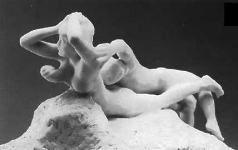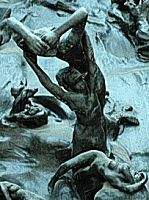Rodin Works: fugit amor |
|
'Fugitive love' is a version of the popular theme of lovers, carried by the wind. Rodin detached this group of lovers from the 'The Gates of Hell', where it replaced 'The Kiss' around 1887 as the dominant group at the left door. Again, the love couple represents Francesca da Rimini and Paolo Malatesta, who were murdered for their illicit love affair and eternally damned. While Rodin's female figure in her tenseness rises aloft,
The male figure later becomes an isolated
personality the 'The Prodigal Son' in an upright and beseeching position. In his converations with Paul Gsell Rodin points out, that he exaggerated the tension of his muscles to underline the misery of the male
figure: "As he spoke he showed me on a pedestal nearby one of his most beautiful statues, a young man kneeling, raising suppliant arms to heaven. All his being is drawn out with anguish. His body is thrown backwards. The breast heaves, the throat is tense with despair, and the hands are thrown towards a mysterious being to which they long to cling."
Paolo's head is used several times in 'The Gates of Hell' – e.g. in 'Paolo and Francesca' and in 'Ugolino and his sons' - and known as 'Head of Sorrow' as an isolated fragment.
|
 his male counterpart has a great deal of trouble in his supine position clinging to his lover.
his male counterpart has a great deal of trouble in his supine position clinging to his lover.
